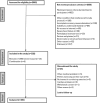Feasibility, safety and patient perceptions of exercise-based cardiac telerehabilitation in a multicentre real-world setting after myocardial infarction-the remote exercise SWEDEHEART study
- PMID: 40395424
- PMCID: PMC12088728
- DOI: 10.1093/ehjdh/ztaf014
Feasibility, safety and patient perceptions of exercise-based cardiac telerehabilitation in a multicentre real-world setting after myocardial infarction-the remote exercise SWEDEHEART study
Abstract
Aims: Cardiac telerehabilitation addresses common barriers for attendance at exercise-based cardiac rehabilitation (EBCR). Pragmatic real-world studies are however lacking, limiting generalizability of available evidence. We aimed to evaluate feasibility, safety, and patient perceptions of remotely delivered EBCR in a multicentre clinical practice setting after myocardial infarction (MI).
Methods and results: This study included 232 post-MI patients (63.7 years, 77.5% men) from 23 cardiac rehabilitation centres in Sweden (2020-22). Exercise was delivered twice per week for 3 months through a real-time group-based video meeting connecting a physiotherapist to patients exercising at home. Outcomes were assessed before and after remote EBCR completion and comprised assessment of physical fitness, self-reported physical activity and exercise, physical capacity, kinesiophobia, health-related quality of life (HRQoL), self-efficacy for exercise, exercise adherence, patient acceptance. Safety monitoring in terms of adverse events (AE) and serious adverse events (SAE) was recorded. A total of 67.2% of the patients attended ≥ 75% of prescribed exercise sessions. Significant improvements in physical fitness, self-reported exercise, physical capacity, kinesiophobia, and HRQoL were observed. Patients agreed that remote EBCR improved health care access (83%), was easy to use (94%) and found exercise performance and interaction acceptable (95%). Sixteen exercise-related AEs (most commonly dizziness and musculoskeletal symptoms) were registered, all of which were resolved. Two SAEs requiring hospitalization were reported, both unrelated to exercise.
Conclusion: This multicentre study supports remote EBCR post-MI as feasible and safe with a high patient acceptance in a real-world setting. The clinical effectiveness needs to be confirmed in a randomized controlled trial.
Trial registration number: NCT04260958.
Keywords: Cardiac rehabilitation; Coronary artery disease; Exercise; Secondary prevention; Telerehabilitation; eHealth.
© The Author(s) 2025. Published by Oxford University Press on behalf of the European Society of Cardiology.
Conflict of interest statement
Conflict of interest: none declared.
Figures
References
-
- Sidney S, Quesenberry CP, Jaffe J, Sorel MG, Nguyen-Huynh M, Kushi MN, et al. Recent trends in cardiovascular mortality in the United States and public health goals. JAMA Cardiol 2016;1:594–599. - PubMed
-
- Fox KAA, Carruthers KF, Dunbar DR, Graham C, Manning JR, De Raedt H, et al. Underestimated and under-recognized: the late consequences of acute coronary syndrome (GRACE UK–Belgian study). Eur Heart J 2010;31:2755–2764. - PubMed
-
- Kotseva K, De Backer G, De Bacquer D, Ryden L, Hoes A, Grobbee D, et al. Lifestyle and impact on cardiovascular risk factor control in coronary patients across 27 countries: results from the European Society of Cardiology ESC-EORP EUROASPIRE V registry. Eur J Prev Cardiol 2019;26:824–835. - PubMed
-
- Ambrosetti M, Abreu A, Corra U, Davos CH, Hansen D, Frederix I, et al. Secondary prevention through comprehensive cardiovascular rehabilitation: from knowledge to implementation. 2020 update. A position paper from the secondary prevention and rehabilitation section of the European association of preventive cardiology. Eur J Prev Cardiol 2021;28:460–495. - PubMed
Associated data
LinkOut - more resources
Full Text Sources
Medical



